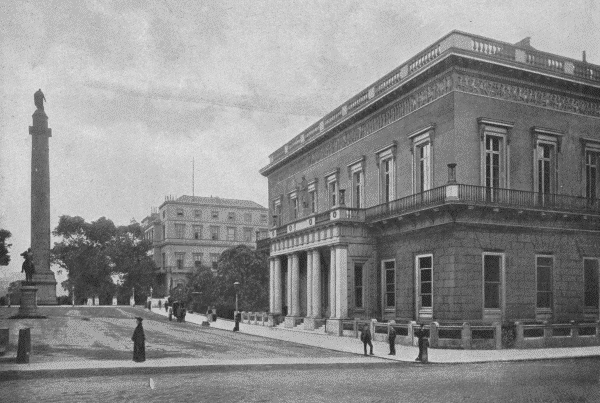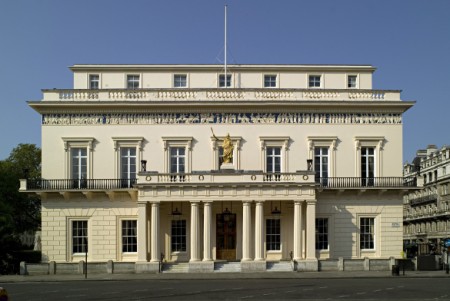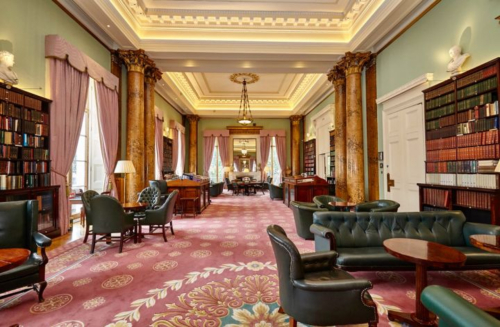
London
Decision-making center, transport hub, London was an inevitable destination for Ernest Rutherford.
Here are a few emblematic places that he honoured with his presence, fleeting, repeated or ... definitive.
Places of Ernest Rutherford's life
Pictures :
-
Piccadilly Circus, c.1880. Source: Spitalfields Life
-
Bacon's New Map of London, c. 1890, detail. Source: Wikipedia .
General map

Royal Society & Royal Institution
These two learned societies were located very close to each other. This has not been the case since the Royal Society moved, but by the time Ernest Rutherford went there, the RS was housed at Burlington House, which is still standing at the same place.
The Royal Institution (shortened to RI or extended to " Royal Institution of Great Britain ") has not, as far as it is concerned, left the building it occupied at the beginning of the 20th century, at 21 Albemarle Street.


Pictures:
-
Piccadilly street in 1900. Burlington House, home of the Royal Society, is the massive and a little lighter building to the left of the street. Albemarle street, where the Royal Institution is located, is the first street on the left. Source: Pinterest .
-
Facade of the Royal Institution on Albemarle street. Source: RIGB .
-
Burlington House on Piccadilly in 1873. Source: Wikipedia
-
Faraday lecture theater at the Royal Institution. Source: Wikipedia .
-
Meeting Room SR house in Burlington in 1906. Source: Wikipedia
To learn more about each of these two organizations, I invite you to read, on the one hand, the section concerning the Royal Society and, on the other hand, that describing the Royal Institution on the page devoted to the Institutions in which Ernest Rutherford played a role.





University College London & Mortimer street

But Ernest barely has time to greet the two British chemists: Soddy immediately takes him to his "radium supplier defying all competition"..
This is Isenthal & Co., whose store is located not far away at 85 Mortimer Street.
In the spring of 1903, Ernest Rutherford crossed the Atlantic from Montreal to come and defend his theory of radioactive decay in England. He took the opportunity to make a short trip on the continent, going to Geneva, then to Paris. There, he receives a postcard from his former partner, Frederick Soddy (with whom he had just developed the above-mentioned theory in Montreal). Soddy informs Rutherford that Marie Curie wishes to see him; and he also mentions that he found in London a supplier of radium whose prices are unbeatable.
At the end of his stay in Paris (during which he was able to meet Marie and Pierre Curie), Ernest returned to the English capital. He then visits Soddy, now stationed at University College, in the laboratory of the famous William Ramsay.


Pictures:
University College London (UCL) at the end of the 19th century. Source: Michael Heath-Caldwell .
Frederick Soddy in his Glasgow laboratory (where he was posted from 1904 to 1914, so after his time at UCL). Source: Linda Hall Library .
William Ramsay in his lab at UCL. Source: UCL .
Isenthal, & Co. advertisement, in W ireless telegraphy; a popular exhibition, GW von Tunzelmann, 1902. Source: Archive.org .
Corner of Mortimer Street (with 85 highlighted) and Great Portland Street. Source: Pearl & Coutts .
Bacon's New Map of London, c. 1890, detail corresponding to the area marked "Plan 2" on the general plan of London at the beginning of the page. Source: Wikipedia .



In a long, very detailed article, titled "A Brief History of Lord Rutherford's Radium," Science historian (and jazz pianist ) Neil Todd cites several recollections of Soddy himself about this episode:
“Our trouble here was the same as in Montreal. We had a quite insufficient amount of radium for our investigations. Then, by the most extraordinary chance, the whole future prospect was changed. … I was walking along Mortimer St off Upper Regent Street, in London one day when, casually looking through Isenthal's window, I saw advertised something I could not credit to be true: ‘pure radium compounds on sale here’. … I learnt from the salesman that Professor Giesel in Germany … had started manufacture of radium compounds on a commercial scale in the Chinin Fabrik at Brunswick. He used residues left after the extraction of uranium from the Pitchblende found in the old state silver mine of St Joachimsthal in Bohemia. Isenthal had quickly taken advantage of this supply. At that time one could buy radium only from the French factory by favour of the Curies. Here it was to be bought in a London shop at some eight shillings a milligram of pure radium bromide. "
Faced with such a windfall, Soddy decides to buy 20 mg of radium bromide. This takes place in early July 1903, shortly before Rutherford's visit to University College. Which is related by Soddy as follows:
"I told him immediately on his arrival at UCL about my find at Isenthal's and together we lost no time in walking round to Mortimer St. I must say he experienced the same astonishment and joy that I had experienced when confronted with radium bromide for eight shillings a milligram some weeks before. He was absolutely bowled over and became as excited as a school boy over the coming holidays. With thirty precious milligrams of pure radium bromide we bounded back to Gower Street and we both immediately repaired to the dark room with some metal foils and a bit of X-ray screen. The effect was terrific; it was like a person born blind suddenly being given sight, for though R had made a special study of the Becquerel rays, this was the first time he had ever seen them. All his work had been done by the ionization method with substances far too feebly radioactive to light up the X-ray screen. Now he had a visual demonstration of what he had found out in the dark — so to speak. "
The video opposite gives an idea of what Ernest Rutherford discovered in 1903 in the chemistry lab at University College. The only difference here is that the radioactive material used is not radium, but polonium (which is also a chemical element discovered by Marie Curie).
Source: Philip Evans Youtube channel
But this courtesy visit to Ramsay and Soddy was not so sympathetic throughout. Because besides the happiness of Ernest to have unearthed a seller of radium so inexpensive and to have been able to contemplate on a screen the effect of the radioactive particles that he had been studying for so long, his time at UCL was also a source of annoyance. And the opportunity to discover the personality of Soddy a little better.
Indeed, in order to avoid duplication and loss of time, the two researchers had distributed the research tracks before Soddy took up his post in London, leaving Rutherford behind in Montreal. What Ramsay and Soddy did at University College in July 1903 was the experimentation attributed to Rutherford. Ernest already knew that his former collaborator was not easy going, but then he discovered that he was not really reliable.
Annoyed, however, he did not show it and even made a generous gesture for the benefit of the two English chemists. Because, in his eyes, science was much more important than self-esteem.
The fact is that, thanks to William Macdonald, he had much greater financial means than those of Soddy and Ramsay: so he didn't just take 20 milligrams of radium bromide: he took 100. And seeing the result that the two Englishmen obtained (by carrying out the experiment they shouldn't have done), he decided to take 30 mg from what he had just bought, to enable them to start the tests again and confirm their conclusions.
He returned to Montreal without being certain that he would one day be reimbursed for this raw material. But Soddy, despite everything, is honest (for once) and the 30 mg are returned a few months later.
Meanwhile, Soddy wrote to Rutherford on July 13 the following message:
“If you received my wire you will have heard the results of the second experiment with your radium. … It is a veritable triumph and we are very grateful to you for making it possible. Your radium weighed 31.8 mg and I hope soon to hear from the manufacturers when I shall get my 30 mg from them. "
Sources :
-
A brief history of Lord Rutherford's radium, Neil Todd, 2014
-
Radium and the Secret of Life, Luis A. Campos, page 14-15
Bayswater
In May 1907, Ernest Rutherford left Montreal to take up his new post at Victoria University in Manchester .
He arrives in Liverpool with May and Eileen, but while he reaches his new hometown, his wife and daughter travel to London.
The Rutherford family do not yet have a home in Manchester, and on top of that May wants to meet acquaintances and reunite with her own mother who has once again made the trip from New Zealand.
They make their home in the district of Bayswater, west of central London and just above Hyde Park. Their hotel is Prince's Square, at 23 on the square of the same name (and it still exists).


Since she is on the same side of the Atlantic as her, May offers Harriet Brooks to join her in London. The Canadian physicist has been working in Paris for a few months in Marie Curie's team. The latter would have liked to keep Brooks with her... but Rutherford also offered his ex-colleague to resume working with him, in the new team he was about to form in Manchester.
Harriet accepts May's invitation to join her in London. Of course, she appreciates meeting this friend she knew in Montreal, but she also wants to be able to find a trusted person to ask for advice. This does not concern the job offers made to her: she has no doubts: it is with Rutherford and not with Curie that she prefers to continue her research work. What puts her in the most painful uncertainty are the numerous (very numerous) advances she receives from another character she had known in Montreal a few years earlier. Frank Pitcher was a demonstrator in the lab where she worked with Rutherford. He left to join the Montreal water company. For her part, Harriet Brooks left for the United States, then for Europe, in the company of Maxime Gorki, the latter's wife and the pianist Burenine. Which eventually returned to Russia. Leaving Harriet alone.
It was at this moment that Pitcher began an intense epistolary seduction campaign: Harriet received postcard after postcard, and heaps of letters, first in Italy, where she went with her Russian friends, then to Paris and finally London, when she answers May Rutherford's invitation.
How Pitcher was able to know his successive addresses; it's a mystery. But this detail troubles her much less than this question: should she marry him or continue her career as a researcher?
The answer she chooses is manifested by the event that takes place on July 13, 1907 in another building in the district of Bayswater: St. Matthew's Church. It was in this place that Harriet Brooks married Frank Henry Pitcher that day, in the presence of four witnesses, including May and Ernest Rutherford.
Frank Pitcher got what he wanted: he returned to Canada with his new wife. They will have three children. She will never do research again.


Pictures:
-
Overview of the Prince's Square Hotel. Source: Star4hotels
-
Entrance to the hotel. Source: Google Maps
-
Perspective to the south of the street which passes in front of the hotel (on the left before the tree) and in front of St-Matthews. Source: Google Maps
-
Insert published in "The gazette Montreal", July 15, 1907. Source: Findagrave .

Train stations

Charing Cross Station was the point of arrival from the southeast, for example from Gravesend, where ships from New Zealand docked.
Trains from Cambridge ran to Liverpool Street Station.


Euston Station made it possible to reach the north-west of England in particular and therefore linked London to Manchester .


Pictures:
Charing Cross Station viewed from the Strand. Source: IanVisits
Liverpool Street Station circa 1900. Source: History House UK .
Liverpool Street Station, interior view. Source: Spitalfield's Life .
Euston Arch, entrance to Euston Station, in 1896. Source Wikipedia
Euston Station, Grand Hall in 1905. Source Wikipedia
Map of the main railway lines in England in 1898. Source: Wikipedia .

Victory House
Headquarters of the BIR (Board of Invention and Research), Victory House hosted Ernest Rutherford (and some of his friends) on several occasions during the First World War.
See the description of this organization on the page dedicated to the institutions in which Rutherford has been involved.
Picture :
Ernest Rutherford with William Henry Bragg and Robert Strutt at BIR in 1915.
Source: Rutherford's war , by John Campbell, IOP

For the record, no document specifies which building was the BI.R. headquarters.
The press release above, for example, shows that the address is simply Victory House, Cockspur Street, S.W.1.
The address has no number.
The same information appears on letterheads, again without a number.
Obviously, this didn't work for me. To determine the precise address of Victory House, I used the only available photograph of its façade: the one shown above, showing Rutherford, Bragg and Strutt leaving the building.
Even though the visible surface area is limited, you can see in the highest windows the reflection of details characteristic of the building just across the street.
The building across the street is Oceanic House, 1A, Cockspur Street, and thus Victory House was in the building numbered 25.


At the time when the BIR moved into Victory House, the building opposite, Oceanic House, housed the London office of the White Star Line, which offered Atlantic crossings on modern luxury liners. In fact, it was at Oceanic House that tickets were sold for the fatal maiden voyage of the RMS Titanic in April 1912.
And it was from this disaster that the idea was born of first locating icebergs, then submarines or mines, using the principle of echo. The technique for doing this was finalised by Paul Langevin, who came to Victory House on 24 March 1917 to present his work on the subject.
Oceanic House today (source : Google Map)



25 Cockspur Street today (beige building with the 3 arched windows on the first floor) (Source: Google Map)
Map of London, 1897, showing the location of the two buildings at 1 and 25 Cockspur Street. Source: National Library of Scotland

Athenaeum Club
Rutherford was elected a member of this club in 1917.
Established in 1824, it has been housed since 1830 in a "Greek Revival" style building on the corner of Pall Mall and Waterloo Place.
Members of this club were Michael Faraday, Charles Dickens, Charles Darwin, Benjamin Disraeli, Arthur Conan Doyle or, more recently, Yehudi Menuhin or Michael Palin (current member).

However, Ernest had already come to this place seven years before being officially welcomed as a member: on June 30, 1910, Nicholas Murray Butler, President of Columbia University had indeed chosen this setting to organize a dinner in the honor of Ernest. The reason was that Columbia had awarded Professor Rutherford one of its highest honors, the Barnard Medal. It was not comparable to a Nobel Prize, but two years after receiving one, this additional award was still pleasing.


Pictures:
-
The club house in 1896. Source: Victorian London
-
The club house in today's era (exterior view) and "The Drawing Room" (interior view). Source: official club website .
-
The entrance hall of the club circa 1850, painted by William Radclyffe. Source: Wikipedia .
-
The entrance hall of the club in 2010, after refurbishment inspired by the original appearance. Source: Patrick Baty .


Westminster Abbey


The ashes of Ernest Rutherford were placed in the nave of Westminster Abbey, along with the remains of kings, queens, writers or scientists of the same stature.
Around his tombstone are other big names in science, such as Isaac Newton, Charles Darwin, John Herschel, William Herschel, James Clerk Maxwell, Michael Faraday, Lord Kelvin, Paul Dirac or Stephen Hawking.
His closest neighbor is the one who mentored him in Cambridge and remained his friend all his life: Joseph John Thomson.
This Scientists Corner is located on the left side, as shown by the red circle on the attached map. On the exterior photo of the collegiate church, this corresponds to the side bordered by the lawn visible in the foreground. (Map source: Wikipedia / Photo source : Branipick .)

On the Abbey website, it is possible to find the complete list of all the scientists buried in this place .
In the left column, you must select the "occupation" item and check the "physicist" and "scientist" boxes.
And to visit (virtually) the whole church, watch the video below.
-
The conurbations of Great Britain, Thomas Walter Freeman, 1966
-
The British Isles, 1901-1951, Keith Robbins
-
Professor Stephen Hawking will rest between Sir Isaac Newton and Charles Darwin at Westminster Abbey, Daily Mail 15 juin 2018.